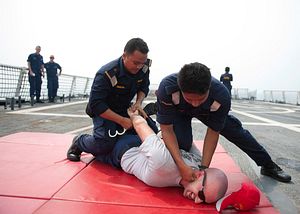Over the past few weeks, we have seen a number of engagements between the coast guards of the United States and Southeast Asian states. While these interactions themselves may not attract many headlines in and of themselves, they deserve mention as part of a broader trend of increasing collaboration between the United States and the coast guards and maritime law enforcement agencies of Southeast Asian countries as part of Washington’s broader approach to Indo-Pacific security.
U.S. cooperation with Southeast Asia’s coast guards itself is not new. Indeed, Washington has played an important and often underappreciated role in assisting regional states with the development of their navies and newer maritime law enforcement agencies (MLEAs) over the years through various means including education, training, or capacity-building, even though the spotlight tends to be on select initiatives such as the Southeast Asia Maritime Security Initiative (MSI) or the Gulf of Thailand Maritime Law Enforcement Initiative (GOTI).
Nonetheless, the trend has been intensifying over the past few years as well. Part of this is a reflection of the rising role – whether actual or potential – that MLEAs play in the maritime security of Southeast Asian states themselves. And part of it is also a reflection of the recognition by Washington that engaging these actors is important in helping the United States navigate gray zone security challenges in the Indo-Pacific region, including the South China Sea and China’s involvement there which relies on the use of non-military vessels to advance Beijing’s objectives beyond the threshold of war. Back in June, U.S. Coast Guard Pacific Area Commander Linda Fagan told a conference call that growing Coast Guard involvement in the region could help with law enforcement and capacity-building to address a range of maritime security challenges.
We have seen manifestations of this put into practice this year as part of ongoing collaboration. Back in May, the U.S. Coast Guard cutter Bertholf – one of the vessels deployed within the U.S. Navy’s Seventh Fleet – held a joint search-and-rescue exercise with the Philippine Coast Guard (PCG) and then made a port call to Manila, which Fagan told a conference call was the first visit of its kind in seven years. And from a more multilateral perspective, in terms of publicized engagements, back in June, there was an engagement held under the Southeast Asia Maritime Law Enforcement Initiative (SEAMLEI) – hosted by Indonesia’s coast guard, BAKAMLA, and supported by the United States, that featured involvement from Cambodia, Indonesia, Malaysia, Thailand, and Vietnam – that included a workshop as well as an exercise. Coast guard involvement has also been seen as part of ongoing U.S. exercises with Southeast Asian states, including in this year’s iteration of the Southeast Asia Cooperation and Training (SEACAT) exercises which are set to wrap up later this week before the launch of the first-ever U.S.-ASEAN Maritime Exercise.
In a continuation of this trend, increasing coast guard cooperation between the United States and Southeast Asian states has been in the spotlight over the past few weeks as well with some significant firsts. For instance, from August 9-11, the U.S. Coast Guard conducted its first-ever joint exercise with BAKAMLA of its kind. And following that, from August 14-18, this year’s iteration of the U.S.-Malaysia Maritime Training Activity (MTA), MTA Malaysia 2019, featured the inaugural participation of the coast guard forces on both sides as well, with the U.S. Coast Guard and the Malaysian Maritime Enforcement Agency (MMEA).
These engagements themselves ought to be viewed as building off of existing U.S. collaboration with Southeast Asian MLEAs, rather than new developments in and of themselves. And they are only one aspect of Washington’s efforts in this vein, with ongoing work in areas such as education and equipment transfers and also collaboration with other allies and partners also active in the maritime security domain, including Japan. Nonetheless, they do underscore the United States’ growing efforts to work with individual MLEAs including coast guards more directly and extensively as part of its wider regional security approach.
To be sure, it is still early days in the trend of rising U.S. collaboration with Southeast Asian coast guards, and U.S. officials have indicated that much more is in the works as well. There are still limitations to consider too – whether on the U.S. side, where officials, including Fagan herself, have previously testified to constraints that limit the U.S. Coast Guard’s capabilities, or on the Southeast Asia side, where there are serious capacity shortfalls among coast guard forces, many of which have only recently been formed and are still hobbled by manifold challenges including the lack of coordination in maritime security policy and fierce bureaucratic rivalries.
Nonetheless, the general trend of rising coast guard collaboration between the United States and Southeast Asian states continues to be an important trend to watch. It is a development that could factor into broader implications for the United States and specific Southeast Asian countries, but also for the regional security order more generally.

































